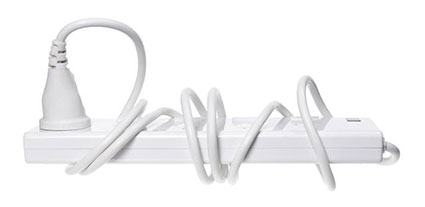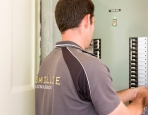When was the last time you checked the safety of your extension leads? For many people, extension leads can seem like the perfect solution to a lack of electrical outlets. Used correctly, they are a safe, temporary measure. Unfortunately, long-term use of extension leads, or leads that aren’t used properly, can pose a significant electrical hazard. Read on for top extension lead safety tips, as well as some telltale signs that you need more power outlets installed.
– Only one appliance should be plugged in / extension lead socket. Don’t use plug-in, three-way adapters with an extension lead in order to try and increase the number of appliances that can be powered from the same lead.
– Extension leads should be out in the open! They are not a substitute for permanent wiring, which means walling them in, or embedding them in plaster or similar, can be dangerous. When in use, extension leads can emit heat. Without appropriate ventilation, the risk of fire increases significantly.
– Use extension leads in safe environments. Moisture and high temperatures can both increase the risk of extension leads failing. If you intend to use an extension lead in an environment where these sorts of conditions are likely (for example outdoors, or to power plumbing tools), use a lead that’s been specifically designed for hazardous conditions.
– Don’t join extension leads together. When leads are joined together, the power passing through them can be reduced (a drop in voltage). This means power still reaches your appliances, but may not be high enough to trigger the safety measures already in place (fuses, trip switches etc). If a power surge occurs unexpectedly, this can leave your appliances vulnerable to damage, as well as increase the risk of an electrical fire. If someone is operating an appliance when the surge occurs, they may also suffer an electric shock.
– Make sure that, during use, the extension lead is fully uncoiled. It also needs to be able to run freely – tacking it in place with staples or similar increases the risk of damage to the insulation which surrounds the cable.
– Regularly check any extension lead you use for signs of wear and tear. Exposed wiring, missing insulation or a kink that won’t come out of the cable once it’s unrolled can all be signs that it is dangerous to use.
– Extension leads can be a health & safety hazard. Never place a lead where it could be a trip hazard. Similarly, be aware of machinery operating near the extension lead, which could cut or damage it: running the lawnmower over an extension lead, for example, is a common risk.
Extension leads are only ever meant to be used as a temporary solution. If you find that extension leads are being used for longer periods of time, it’s a sign that you need more power points. The Smillie Electrical team can fit power sockets safely and easily, wherever you need them. Contract us to find out more.



